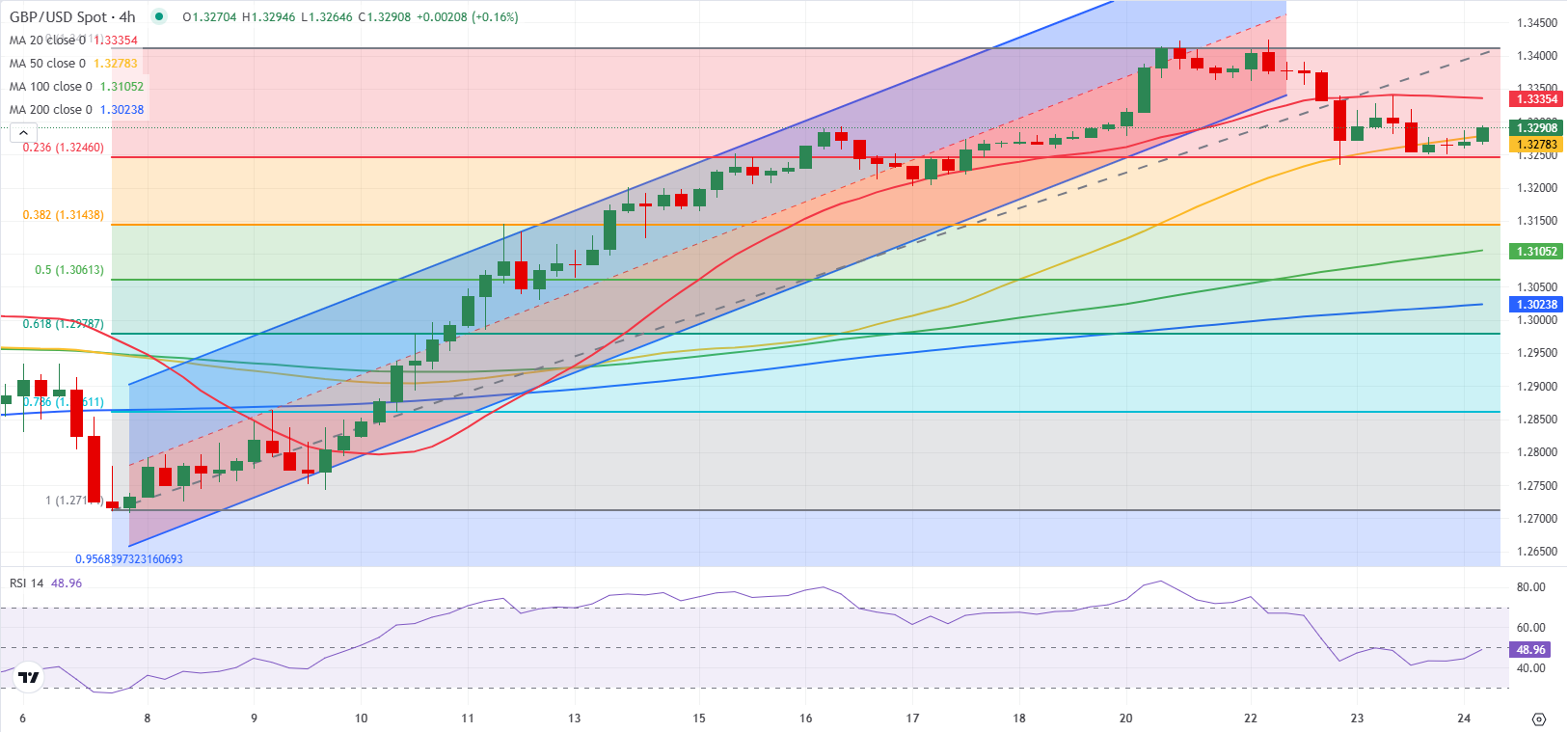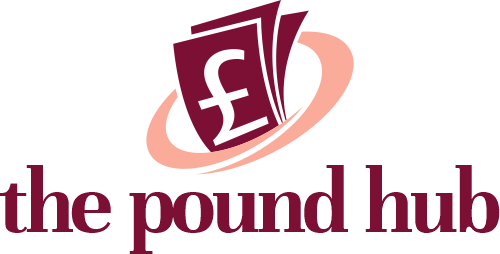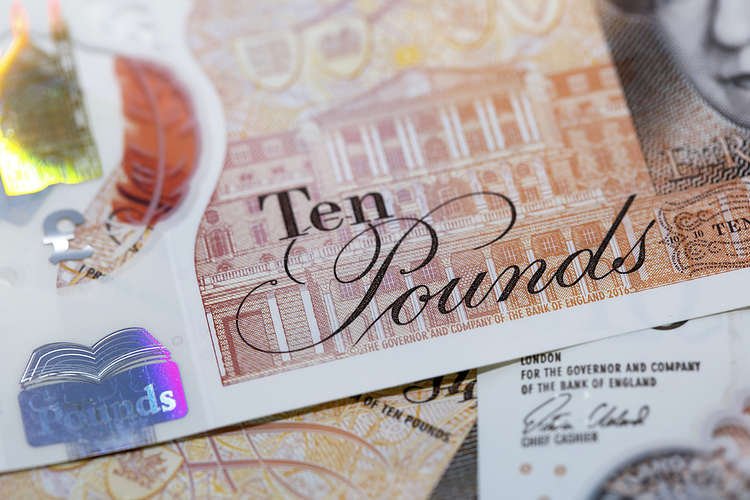- GBP/USD rebounds toward 1.3300 after closing deep in negative territory on Wednesday.
- Technical sellers could take action and drag the pair lower if 1.3250 support fails.
- Markets will keep a close eye on headlines surrounding US-China trade relations.
GBP/USD extended its decline into a second consecutive day on Wednesday and registered its lowest daily close in a week near 1.3250. The pair holds its ground early Thursday and recovers toward 1.3300.
British Pound PRICE This week
The table below shows the percentage change of British Pound (GBP) against listed major currencies this week. British Pound was the weakest against the New Zealand Dollar.
| USD | EUR | GBP | JPY | CAD | AUD | NZD | CHF | |
|---|---|---|---|---|---|---|---|---|
| USD | 0.15% | 0.02% | 0.36% | -0.04% | -0.01% | -0.70% | 1.21% | |
| EUR | -0.15% | -0.28% | 0.18% | -0.23% | -0.33% | -0.87% | 1.04% | |
| GBP | -0.02% | 0.28% | 0.63% | 0.07% | -0.06% | -0.59% | 1.34% | |
| JPY | -0.36% | -0.18% | -0.63% | -0.40% | -0.47% | -0.91% | 0.90% | |
| CAD | 0.04% | 0.23% | -0.07% | 0.40% | -0.08% | -0.64% | 1.28% | |
| AUD | 0.00% | 0.33% | 0.06% | 0.47% | 0.08% | -0.52% | 1.38% | |
| NZD | 0.70% | 0.87% | 0.59% | 0.91% | 0.64% | 0.52% | 1.96% | |
| CHF | -1.21% | -1.04% | -1.34% | -0.90% | -1.28% | -1.38% | -1.96% |
The heat map shows percentage changes of major currencies against each other. The base currency is picked from the left column, while the quote currency is picked from the top row. For example, if you pick the British Pound from the left column and move along the horizontal line to the US Dollar, the percentage change displayed in the box will represent GBP (base)/USD (quote).
The disappointing Purchasing Managers Index (PMI) data from the UK, which showed a contraction in the private sector’s business activity in April, caused Pound Sterling to weaken against its rivals during the European trading hours on Wednesday. Later in the day, the US Dollar (USD) benefited from heightened optimism about easing tensions between China and the US, causing the pair to stretch lower.
The Wall Street Journal reported that the White House was considering slashing tariffs on Chinese goods to de-escalate the trade conflict. Speaking on the same matter, United States (US) Treasury Secretary Scott Bessent noted that both sides are aware that current tariff levels are not sustainable and said that he would not be surprised if they were to come down in a mutual way.
Early Thursday, however, China’s Commerce Ministry clarified that any content about US-China economic and trade negotiations were groundless and had no factual basis. “If the US really wants to resolve the issue, it should lift all unilateral tariff measures against China,” the ministry said, per Reuters.
This latest development seems to be making it difficult for the USD to find demand and helping GBP/USD rebound.
Later in the session, the US Department of Labor will publish the weekly Initial Jobless Claims data. Markets expect the number of first-time application for unemployment benefits to edge higher to 221,000 from 215,000 in the previous week. A positive surprise, with a print at or below 200,000, could support the USD with the immediate reaction and limit GBP/USD’s upside. On the other hand, a disappointing reading of 230,000, or higher, could open the door for an extended rebound in the pair.
GBP/USD Technical Analysis

The Relative Strength Index (RSI) indicator on the 4-hour chart stays slightly below 50 and GBP/USD continues to trade at around the 50-period Simple Moving Average, reflecting GBP/USD indecisiveness in the near term.
On the downside, the Fibonacci 23.6% retracement of the latest uptrend aligns as a key support level at 1.3250. If GBP/USD falls below this level and starts using it as resistance, additional losses toward 1.3200 (static level) and 1.3150 (Fibonacci 38.2% retracement) could be seen. Looking north, interim resistance could be spotted at 1.3300 (static level) ahead of 1.3335 (20-period SMA) and 1.3400-1.3410 (round level, static level).
Pound Sterling FAQs
The Pound Sterling (GBP) is the oldest currency in the world (886 AD) and the official currency of the United Kingdom. It is the fourth most traded unit for foreign exchange (FX) in the world, accounting for 12% of all transactions, averaging $630 billion a day, according to 2022 data.
Its key trading pairs are GBP/USD, also known as ‘Cable’, which accounts for 11% of FX, GBP/JPY, or the ‘Dragon’ as it is known by traders (3%), and EUR/GBP (2%). The Pound Sterling is issued by the Bank of England (BoE).
The single most important factor influencing the value of the Pound Sterling is monetary policy decided by the Bank of England. The BoE bases its decisions on whether it has achieved its primary goal of “price stability” – a steady inflation rate of around 2%. Its primary tool for achieving this is the adjustment of interest rates.
When inflation is too high, the BoE will try to rein it in by raising interest rates, making it more expensive for people and businesses to access credit. This is generally positive for GBP, as higher interest rates make the UK a more attractive place for global investors to park their money.
When inflation falls too low it is a sign economic growth is slowing. In this scenario, the BoE will consider lowering interest rates to cheapen credit so businesses will borrow more to invest in growth-generating projects.
Data releases gauge the health of the economy and can impact the value of the Pound Sterling. Indicators such as GDP, Manufacturing and Services PMIs, and employment can all influence the direction of the GBP.
A strong economy is good for Sterling. Not only does it attract more foreign investment but it may encourage the BoE to put up interest rates, which will directly strengthen GBP. Otherwise, if economic data is weak, the Pound Sterling is likely to fall.
Another significant data release for the Pound Sterling is the Trade Balance. This indicator measures the difference between what a country earns from its exports and what it spends on imports over a given period.
If a country produces highly sought-after exports, its currency will benefit purely from the extra demand created from foreign buyers seeking to purchase these goods. Therefore, a positive net Trade Balance strengthens a currency and vice versa for a negative balance.







